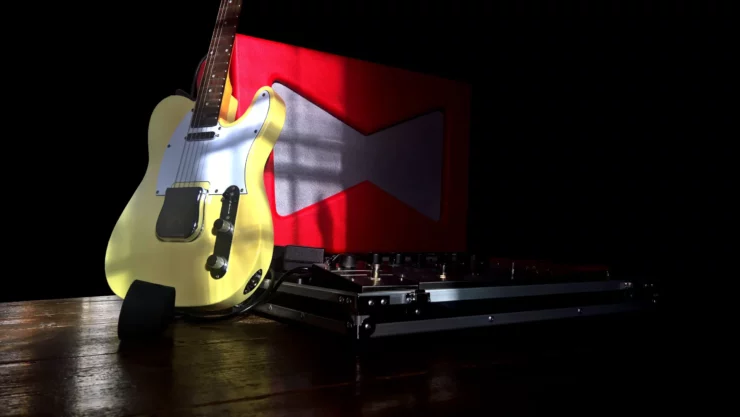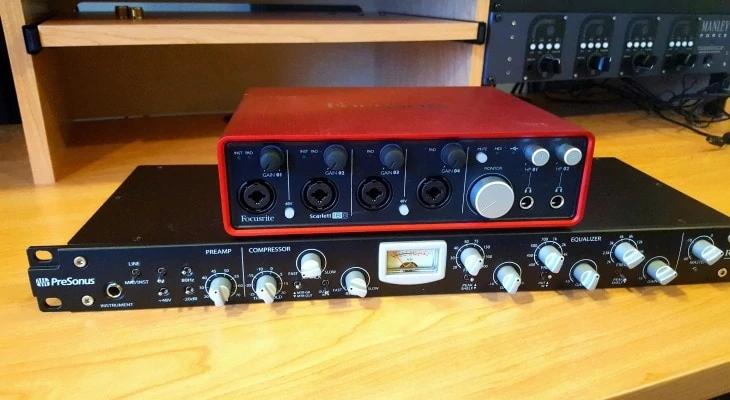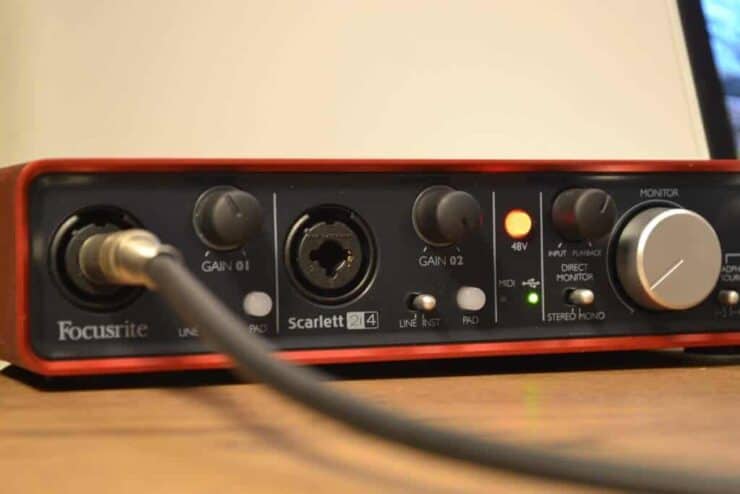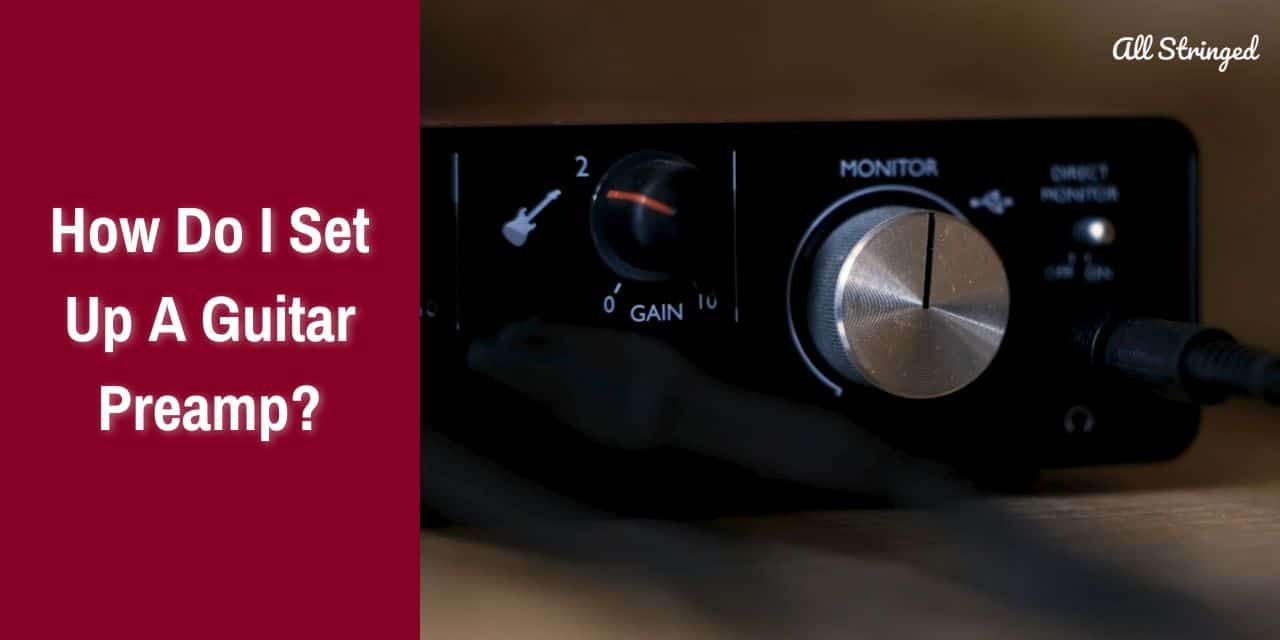Are you ready to take your guitar playing to the next level? Setting up a guitar preamp is a great way to increase the quality of your sound. Whether you’re a seasoned pro or just starting out, this article will guide you through the process of connecting and using a preamp effectively. Read on to find out how to set up your preamp and unlock new possibilities for your playing.
What does a guitar preamp do?
A guitar preamp is an important component of any electric guitar’s signal chain. It plays a key role in shaping and enhancing the instrument’s sound before it reaches the amp. A guitar preamp, short for preamplifier, is an electronic circuit that boosts and shapes the weak electrical signal produced by the guitar’s pickups. It serves as the initial stage of amplification in the signal chain, preparing the signal for further processing and amplification by the power amp section of an amp.
The primary function of a guitar preamp is to amplify the weak electrical signal generated by the guitar’s pickups. The signal from the pickups is relatively low in voltage and has to be boosted to a level that can be effectively processed and amplified by the power amp. The preamp circuit employs transistors or tubes to amplify the signal while preserving its tonal characteristics.
Guitar preamps often come with built-in equalization controls, commonly referred to as tone controls or EQ knobs. These controls allow the guitarist to shape the tonal characteristics of the signal. The most common EQ controls found on guitar preamps are bass, midrange, and treble knobs. Adjusting these controls will enable the guitarist to emphasize or attenuate specific frequency ranges, allowing for tonal sculpting and customization.
>>> Click here to read our review about the Top 15 Best Guitar Preamps <<<
Another important element of a guitar preamp is the gain control, also referred to as the drive or volume control. The gain control adjusts the level of distortion or overdrive in the signal. By increasing the gain, the signal will be driven harder, resulting in a more saturated and distorted sound. Lower gain settings produce cleaner tones. This feature will allow guitarists to achieve a wide range of tones, from clean and pristine to heavily distorted and saturated.
Some guitar preamps offer additional signal processing capabilities. These might include built-in effects, such as reverb, delay, chorus, or modulation effects. Moreover, certain preamps might incorporate cabinet simulation, which emulates the sound characteristics of different speaker cabinets, enabling direct recording or live performance without the need for external speakers.
The output stage of a guitar preamp will be responsible for delivering the amplified signal to the power amp or external recording device. The output stage will ensure proper impedance matching and signal level adjustment to interface effectively with subsequent amplification stages or recording equipment.
Guitar preamps can be standalone units, integrated into amplifier heads or combo amps, or incorporated into multi-effects processors. In amplifier heads or combo amps, the preamp section is often paired up with a power amp, allowing the complete amplification of the guitar signal. In multi-effects processors, the preamp section will be combined with various effects and signal processing capabilities, offering a versatile all-in-one solution for guitarists.
What are the benefits of using a guitar preamp?
In the world of electrical guitars, the quest for achieving the perfect tone is a never-ending pursuit. Guitarists often turn to different tools and equipment for shaping their sound and enhancing their playing experience. One such tool that offers a multitude of benefits is the guitar preamp. Here are some of the benefits of using a guitar preamp and how it can elevate your playing and tone to new heights.

#1. Signal conditioning and amplification
One of the major benefits of a guitar preamp is its ability to condition and amplify the guitar’s signal. As the first stage of amplification happens in the signal chain, a preamp will take the low-level signal produced by the guitar’s pickups and boosts it to a suitable level for further processing and amplification. This ensures that your guitar’s signal remains strong and consistent throughout the signal chain, resulting in improved signal integrity and overall tonal quality.
#2. Tonal shaping
A guitar preamp offers an impressive range of tonal shaping options, allowing you to sculpt your sound to your exact preferences. With built-in equalization controls like bass, midrange, and treble knobs, you’ll be able to adjust the frequency response of your guitar’s signal. This will give you the ability to boost or cut specific frequency ranges, enhancing clarity, presence, or warmth according to your playing style and musical genre.
#3. Versatility and flexibility
Using a guitar preamp opens up a world of tonal possibilities and versatility. By adjusting the gain control, you’ll be able to dial in the desired amount of overdrive or distortion, ranging from crystal-clear cleans or crunchy blues tones to high-gain metal sounds. This versatility will allow you to adapt your tone to different musical contexts, whether you are performing live, recording in the studio, or exploring different genres and playing styles.
#4. Consistency and convenience
Having a dedicated guitar preamp will ensure consistency in your tone across different amplification systems. Whether you are playing through a tube amp, solid-state amp, or direct recording interface, your amp will provide a consistent tonal foundation. This consistency is especially valuable when you’re performing live as it’ll allow you to retain your signature sound regardless of the venue or amplification setup.
#5. Integration with effects and recording
Many guitar preamps offer built-in effects and signal-processing capabilities. These can include delay, reverb, modulation, and more. Having these effects integrated into the preamp simplifies your setup, eliminating the need for additional pedals or processing units. Moreover, if you are recording directly into a DAW or interface, a guitar preamp having a cabinet simulation will allow you to achieve authentic amp tones without the need for miking a physical amp.
#6. Portability and cost-effectiveness
For musicians and guitarists who frequently gig or travel, using a guitar preamp will provide a compact and portable solution. Standalone preamps or preamp pedals are rather lightweight and easy to transport, making them perfect for touring musicians or those who need a grab-and-go setup. Moreover, investing in a high-quality preamp can be more cost-effective than purchasing multiple amps or effect pedals as it’ll provide a versatile and comprehensive tonal solution in a single unit.
How do I set up a guitar preamp?
A guitar preamp is a rather powerful tool that can shape your guitar’s tone and take your playing the new heights. To utilize its potential completely, it’ll be important to understand how to set up a guitar preamp correctly. Here are the steps you need to follow if you’re wondering how do I set up a guitar preamp and get optimal performance.
Step 1: Connect the preamp to your guitar
First, you should gather the necessary cables. You will require a standalone ¼-inch instrument cable to connect your guitar to the preamp. Then, you should locate the input jack on the preamp. Identify the input jack as it’ll be labeled as “input” or “guitar in”.
Next, you should plug in your guitar. Take one end of the instrument cable and insert it into the output jack of your guitar. Make sure it is securely connected. After that, connect the other end to the preamp. Take the other end of the cable and then insert it into the input jack of the preamp. Moreover, you should ensure a secure connection.
Step 2: Connecting the preamp to your amp
You should be choosing the appropriate cable. Determine the type of connection needed depending on your amp. You might require a standard ¼-inch instrument cable, an XLR cable, or a digital interface cable. Then, you should identify the output options on the preamp. Check the available output options on the preamp. Some of the common options include a dedicated “Output” jack, a balanced XLR output, or a digital interface output.
Then, choose the appropriate output option. Select the output option that matches your amp’s input requirements. For most traditional guitar amps, a standard ¼-inch instrument cable will be sufficient. After that, connect the preamp to the amp. Take the appropriate cable and connect one end to the preamp’s output jack. Connect the other end to the input jack of your amp.

Step 3: Adjusting the preamp settings
Start off by powering on the preamp. Make sure that both the preamp and the amplifier are turned off before you power them on. Then, set the preamp’s volume. Begin by setting the preamp’s volume or gain control to a low level. This will prevent any sudden loud sounds when you power on the system.
Next, you should adjust the equalization (EQ). Use the preamp’s EQ controls, such as bass, treble, and midrange knobs to shape your guitar’s tone. Experiment with different settings to find the desired tonal balance. You should also fine-tune the gain or overdrive. If the preamp has gain control, you should gradually increase the gain to achieve the desired level of distortion or overdrive. Be mindful of maintaining clarity and avoiding excessive noise.
Now, test and adjust in conjunction with amp settings. Once the preamp has been connected and the settings are adjusted, you should power on the amp and adjust its settings accordingly. Pay close attention to the amp’s volume, tone controls, and any effects that you may have connected.
Lastly, you should experiment and refine. Play your guitar and listen to the sound produced through the amp. Tweak the preamp settings as needed for achieving the desired tone and responsiveness. Explore different genres, playing styles, and effects to fully harness the potential of your guitar preamp.
Different types of guitar preamps
A guitar preamp is an important component for shaping and enhancing the tone of an electric guitar. With advancements in technology, there are various types of guitar preamps available to musicians, each with its own unique characteristics and benefits. Here are the different types of guitar preamps, highlighting their features and helping you choose the one that best suits your needs.
#1. Tube preamps
Tube preamps or also referred to as valve preamps are known for their warm and organic sound. They make use of vacuum tubes to amplify and shape the guitar signal. Tube preamps are known for their rich harmonics, smooth compression, and natural distortion when pushed. They offer a classic, vintage-inspired tone highly sought after by many guitarists, especially in blues, rock, and jazz genres.
#2. Solid-state preamps
Solid-state preamps employ transistor-based circuitry to amplify the guitar signal. They are highly regarded for their reliability, clarity, and high headroom. Solid-state preamps offer a more transparent and accurate representation of the guitar’s tone, making them suitable for genres that require clean and pristine sounds such as pop, country, and fusion. They often offer additional features like built-in effects and greater durability compared to tube preamps.
#3. Hybrid preamps
Hybrid preamps combine the best of both major types of preamps, incorporating both tube and solid-state technologies. They typically feature a tube-driven preamp section coupled with a solid-state power amp or other solid-state components. This design aims to capture the warm and dynamic qualities of tube preamps while delivering the reliability and versatility of solid-state technology. Hybrid preamps like a balance between vintage warmth and modern functionality, making them ideal for a wide range of musical styles.

#4. Digital modeling preamps
Modeling preamps use digital technology for replicating the sound characteristics of various amps, cabinets, and effects. These preamps often offer a wide array of tonal options, allowing guitarists to emulate different amps and effects within a single unit. Modeling preamps offer flexibility, convenience, and the ability to recreate iconic tunes from different eras and genres. They are quite popular in recording studios, home studios, and live performance setups.
#5. Software-based preamps
Software-based preamps or also known as virtual preamps or preamp simulators are computer-based plugins or standalone software that simulate the sound of real amplifiers. These preamps can be used in digital audio workstations (DAWs) or live performance setups, offering an impressive selection of virtual amps, cabinets, and effects. Software-based preamps offer an affordable and versatile solution, ideal for home recording, mobile setups, and musicians who prefer the convenience of digital tools.
#6. Rack-mounted preamps
Rack-mounted preamps are designed for professional audio setups, typically found in recording studios or large-scale live performances. These preamps are housed in a rack-mountable chassis alongside other audio processing equipment. Rack-mounted preamps offer high-quality audio conversion, multiple inputs and outputs, advanced routing options, and precise control over different parameters. They’re often preferred by professional engineers and producers looking for maximum control and signal fidelity.
Tips for using a guitar preamp
A guitar preamp is an electronic tool that allows you to easily shape your guitar’s tone and achieve specific sounds. Whether you are a seasoned player or simply starting out, understanding how to effectively use a guitar preamp can greatly enhance your playing experience. If you have an idea of how to adjust the gain and effectively utilize a preamp, it can easily take your playing to new heights. Here are some of the key tips and techniques that you need to keep in mind to help you unlock your guitar preamp’s full potential and make the most out of it. This will help you achieve specific sounds and enhance your musical expression.
#1. Understand the controls
You need to familiarize yourself with the various controls and features of your guitar preamp. These controls will include gain, tone, EQ (bass, treble, mid), presence, volume, and additional effects or boost functions. You should take the time to experiment with each control individually and understand how they impact your tone. This knowledge will empower you to dial in the desired sound for different playing styles and musical genres.
#2. Start with a clean slate
Before you dive deep into complex settings and effects, start with a neutral or clean sound. Set all the controls to their default or 12 o’clock positions. This will give you a neutral starting point from which you’ll be able to shape your tone according to your preferences. Starting with a clean slate will allow you to hear the inherent characteristics of your guitar and preamp, making it much easier to fine-tune your desired sound.
#3. Adjusting the gain
The gain control on a guitar preamp will determine the amount of signal amplification and distortion applied to your guitar’s sound. You need to find the sweet spot. Begin with the gain control set to a low or moderate level and then gradually increase it until you’re able to achieve the desired amount of overdrive or distortion. You should experiment with different gain settings to find the “sweet spot” that suits your playing style and musical genre.
Higher gain settings often tend to compress the guitar’s signal, which results in a smoother and more sustainable sound. However, the excessive gain can reduce the dynamics and touch sensitivity of your playing. You should strike the right balance between gain and dynamics to maintain expressiveness and control.
Rolling back your guitar’s volume knob can effectively clean up the tone when you’re using higher gain settings. This technique will allow you to switch from a distorted sound to a cleaner tone without adjusting the preamp’s gain control. Experiment with volume knob adjustments for exploring a wider range of tonal possibilities.
#4. Use the preamp for specific sounds
A guitar preamp will offer various controls and features that can help you achieve specific sound and tonal characteristics. First, you need to consider tonal shaping with EQ controls. Most preamps tend to include EQ controls such as bass, treble, and midrange. These controls will allow you to shape the frequency response of your guitar’s sound. Experiment with different EQ settings to boost or cut specific frequencies and tailor your tone to suit different muscle contexts.
The preamp’s midrange control is often important for enhancing the sustain and presence of your tone. Adjusting the midrange can add more clarity and definition to your sound. This can make it stand out in a mix or add the cutting edge to your solos.
If your preamp has a dedicated “boost” or “solo” function, you will be able to utilize it and add extra volume and gain to your lead lines or solos. This feature will allow you to cut through the mix and create a much more impactful and dynamic performance.
Many preamps come with an effects loop, which allows you to place the effects pedals after the preamp stage. This placement will get your different sonic results and allow for more precise control over your effects. You can also experiment with placing time-based effects (delay, reverb, etc.) in the effects loop for a cleaner and more spacious sound.
Some guitarists prefer using multiple preamps in their setup to achieve unique tonal characteristics. You should consider blending different preamps or using a dual preamp setup to combine the strengths of different amp models or technologies. This approach can result in richer and more complex tones, giving you a wider tonal palette.
#5. Experiment and trust your ears
You should always remember that there are no strict rules when it comes to using a guitar preamp. The key here is to experiment, trust your ears, and explore different settings and combinations. Spend some time playing around with different gain levels, EQ settings, and effects to discover your unique tone. Every guitar, amp, and preamp combination will bring different results. You shouldn’t be afraid to experiment until you’re able to find the sound that resonates with you.
FAQs
What is a guitar preamp and why do I need one?
A guitar preamp is a device used to boost the signal of a guitar before it is sent to an amplifier. A preamp is important for providing a strong signal to the amplifier, resulting in better sound quality and more control over your tone.
What are the steps for setting up a guitar preamp?
The steps for setting up a guitar preamp include connecting the guitar to the preamp using an instrument cable, connecting the preamp to the amplifier using an output cable, adjusting the preamp settings to your desired sound, and connecting the power source to the preamp.
What should I consider when choosing a guitar preamp?
When choosing a guitar preamp, you should consider the features and controls available, the power rating, the type of amp you are using, and your budget. It’s also important to make sure the preamp you choose is compatible with your setup. For example, if you have a tube amp, you should choose a preamp that is designed for use with tube amps.



